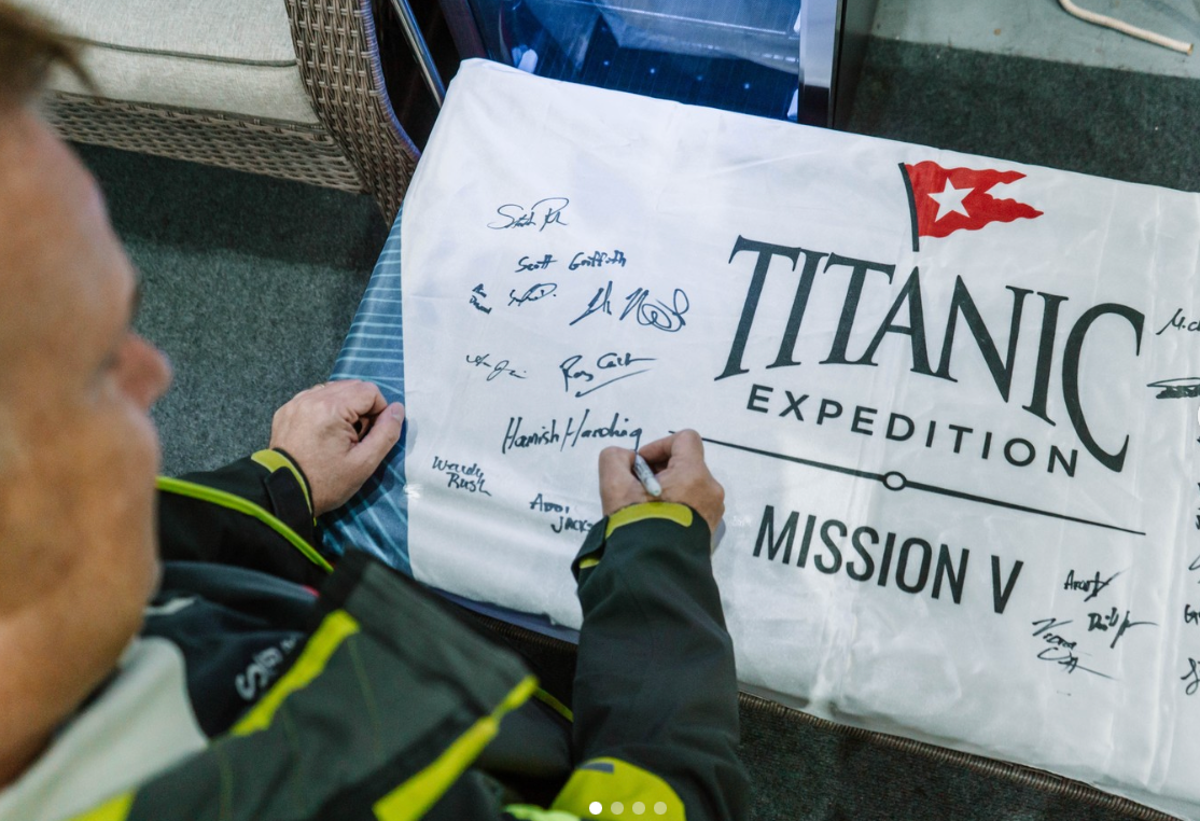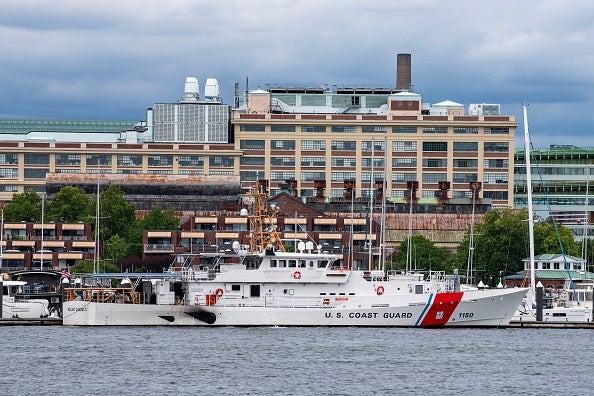
A “catastrophic implosion” on board the Titan submersible vessel claimed the lives of five crew members shortly after its launch on Sunday, the US Coast Guard confirmed on Thursday.
The OceanGate Expeditions vessel was reported missing about 435 miles (700 kilometres) off the coast of Newfoundland, Canada on Sunday night.
Follow live coverage of the missing Titanic sub in our live blog here
A remotely operated vehicle (ROV) located pieces of debris from the Titan on the seabed about 500m from the bow of the Titanic wreck on Thursday morning Rear Admiral John Mauger, the First Coast Guard District commander, told a press briefing.
Oceangate Expeditions CEO Stockton Rush, Pakistani businessman Shahzada Dawood and his son Suleman, British billionaire Hamish Harding, and French adventurer Paul-Henri Nargeolet were confirmed to have died in the implosion.
The company, which charges up to $250,000 to take guests to the Titanic site, said that the five crew members had “sadly been lost” in a statement to The Independent.
“These men were true explorers who shared a distinct spirit of adventure, and a deep passion for exploring and protecting the world’s oceans,” the spokesperson said.
The Titan, pictured, is a tourist sub operated by OceanGate— (OceanGate/YouTube)
The five-person Titan vessel vanished 105 minutes after launching from the Polar Prince icebreaker research ship about 900 miles off the coast of Cape Cod on Sunday morning. The Titan’s twin communication systems — texts and electronic pings — suddenly stopped communicating with the support vessel, and no further sign of life was detected until Thursday’s grim discovery.
The Coast Guard has since revealed that the US Navy detected sounds consistent with an implosion sometime after the Titan lost contact with its mothership.
The information was “immediately shared” with the Incident Commander, and once it had been considered with all of the acoustic data that had been compiled, “the decision was made to continue our mission as a search and rescue” because the noise was “not definitive at the point”, a spokesperson with the US Coast Guard told The Independent.
Billionaire explorer Hamish Harding French diver Paul-Henri Nargeolet, Pakistani businessman Shahzada Dawood and his son Suleman Dawood are now believed to be dead, the Coast Guard and OceanGate have confirmed.
What is OceanGate Expeditions?
OceanGate Expeditions was founded in Washington state in 2009 by US adventurer and former investment banker Stockton Rush.
The trained aerospace engineer began offering underwater tours in specially designed submersible vessels that were developed with NASA.

In an interview with The Independent in 2017, he said he had originally wanted to become an astronaut but was later drawn to underwater exploration.
“In the vacuum of space, by definition there is nothing. That means a great view, but the final frontier for new life forms and discovery is undersea – for the next 200-300 years at least.”
Mr Rush had personally piloted many of the Titan’s 13 previous trips to the famed shipwreck and had insisted the submersible was safe in interviews.
The RMS Titanic has been lying 370 miles off the coast of Newfoundland, Canada in the North Atlantic Ocean since it sank in 1912, killing about 1,500 people on board.
The wreck was discovered in 1985, and was named a UNESCO cultural heritage site in 2012.
It’s been a subject of fascination with deep-sea exploration teams ever since.
Voyaging to the Titanic wreck
In 2021, the company launched its first tour of the North Atlantic wreck site in the Titan, a five-person vessel made of carbon fibre and titanium that can reach depths of 4,000m.
The voyages depart from St Johns, in Newfoundland, Canada, on chartered ocean-faring ships.
For their latest expedition, OceanGate hired the Polar Prince, a medium duty icebreaker that was formerly operated by the Canadian Coast Guard, to ferry dozens of passengers and crew and the submersible craft to the wreck site.
The trip had been scheduled to depart in late May and finish up in late June, according to documents obtained by the AP from the US District Court in Virginia, which presides over the wreck site.
Titan’s viewport is “the largest of any deep diving submersible” and its technology provides an “unrivaled view” of the deep ocean.
The Titan can “withstand the enormous pressures of the deep ocean”, OceanGate said in the court documents.
The Titan’s first voyages to the Titanic wreck gave passengers an up-close glimpse of the world’s most famous shipwreck in its final stages of decay.
This map shows the approximate position of the wreck of the RMS Titanic— (Google Maps)
Footage captured from one expedition showed the famed bathtub in the captain’s quarters that was thought to have been lost to decay was, in fact, still intact.
It showed the ship’s disintegration continued due to salt corrosion, ocean undercurrents, and bacteria that was steadily devouring the shell.
The 2022 expedition featured five missions, each over several days and several dives that could last up to ten hours each.
Each of the dives included at least one scientist or content expert on each submersible to gather “archaeological and biological data” with the goal of understanding behaviour and rarity of life at such a depth while helping to predict the rate of decay of deeply submerged vessels, according to the OceanGate site.
Renata Rojas, who was one of the passengers onboard the 2022 expedition, told The Independent in an interview that seeing the Titanic up close was the fulfilment of a lifelong dream.
The Polar Prince ship is seen while moored in Vancouver, British Columbia— (AP)
“You’re feeling overwhelmed the entire time, not only because [of] just the fact that you were there ... [but] as we were approaching the wreck, I was wowed. That was the feeling,” she said. Ms Rojas is currently on the Polar Prince.
Oceangate’s 2023 expedition was the third year the company had been taking tourists to the Titanic wreck site.
Along with taking visitors to the wreck, OceanGate Expeditions is conducting a longitudinal study of the Titanic’s rate of decay, through images, videos, laser and sonar data.
“Given the massive scale of the wreck and the debris field, multiple missions performed over several years will be required to fully document and model the wreck site,” OceanGate says on its website.
Mr Rush told The Independent in 2017 that the underwater tours were not for everyone.
Hamish Harding posted about his plans to travel to see the Titanic wreckage two days before the sub went missing— (Facebook/Hamish Harding)
“It’s not a chocolate-on-the-pillow job – you’re part of the crew,” he said. “If there’s an electric charge that needs moving in the middle of the night, we’ll grab you.”
Prior to launching the Titanic expeditions, Mr Rush said he had taken former Everest climbers, moviemakers and nautical archaeologists on underwater tours.
His oldest passenger was 92, and his youngest 12 in the four- or five-person vessels.
The OceanGate team have scientists, historians and ‘mission specialists’ who can pay to visit the site— (YouTube/OceanGate Expeditions)
French explorer Paul-Henri Nargeolet, who was on board the fated vessel, told the Irish Examiner in a 2019 interview that the families of some victims of the Titanic were opposed to expeditions to the wreck.
The bodies of around 340 of the estimated 1,500 who lost their lives were recovered after it sank in 1912. He said that those lost at sea would have likely decomposed a long time ago, and he had never seen bodies in the wreckage’s debris field.
He told the news site that exploration of the wreck was about balancing the scientific interest with respect for the dead.
In a chilling foreshadowing of the 2023 disaster, the New York resident made a warning about the dangers of underwater exploration.
“If you are 11m or 11km down, if something bad happens, the result is the same,” Mr Nargeolet said. “When you’re in very deep water, you’re dead before you realise that something is happening, so it’s just not a problem.”







